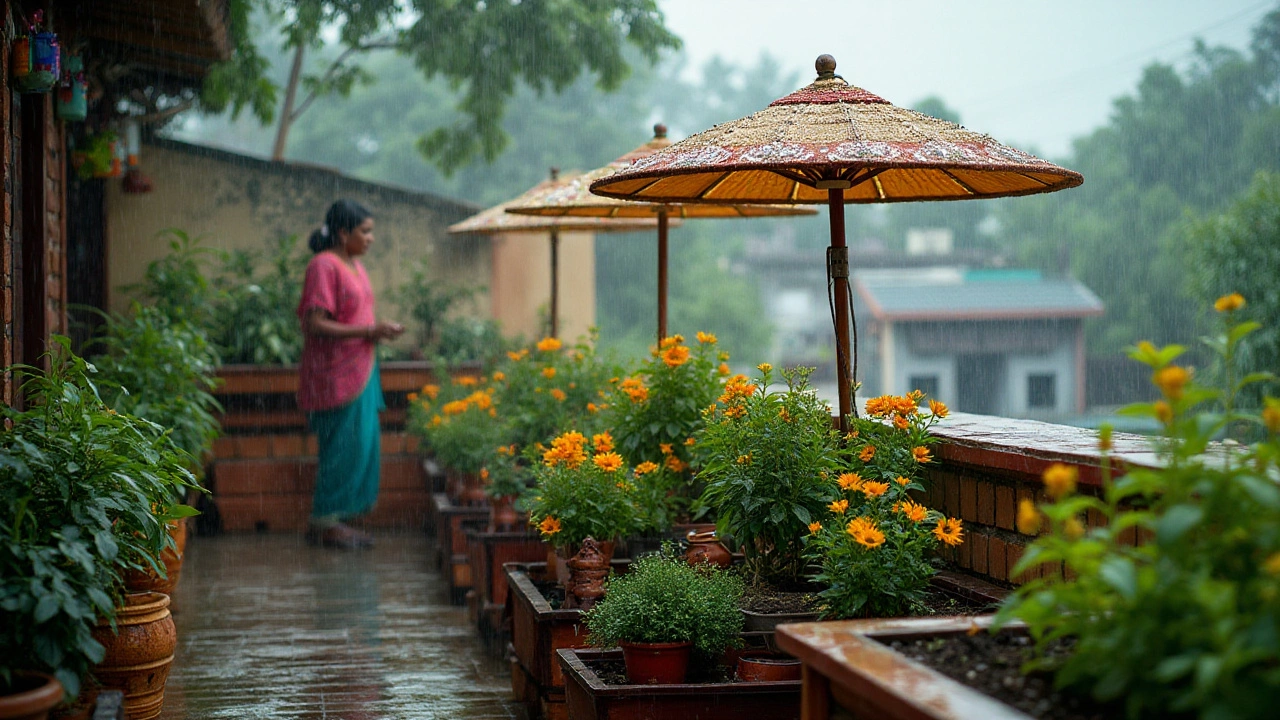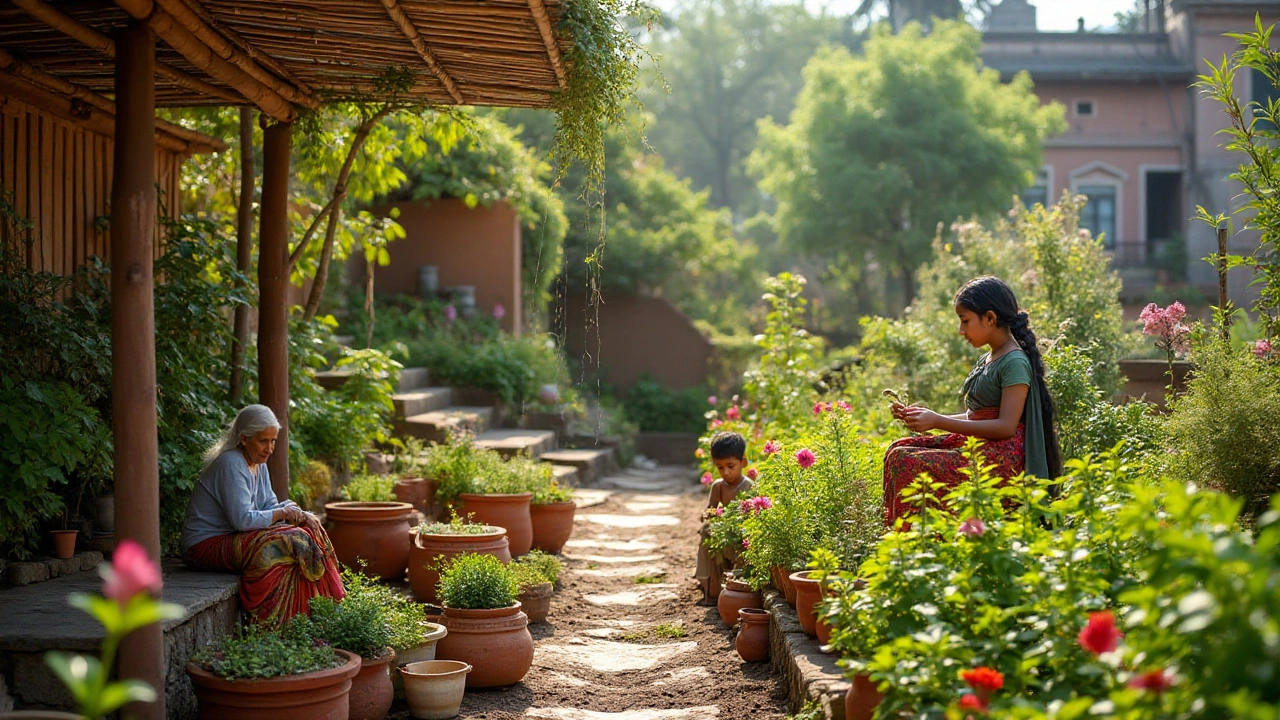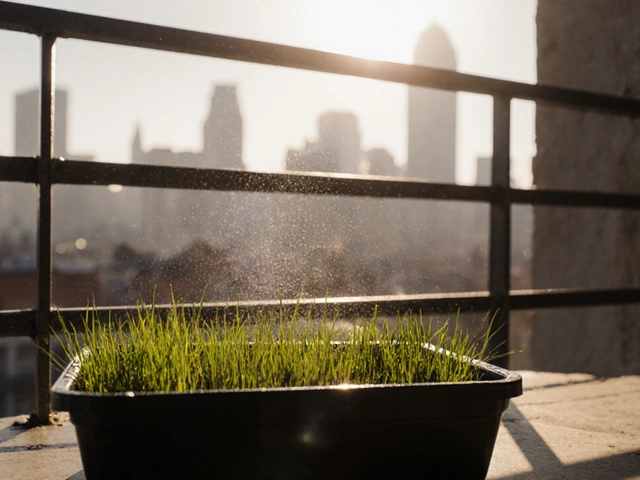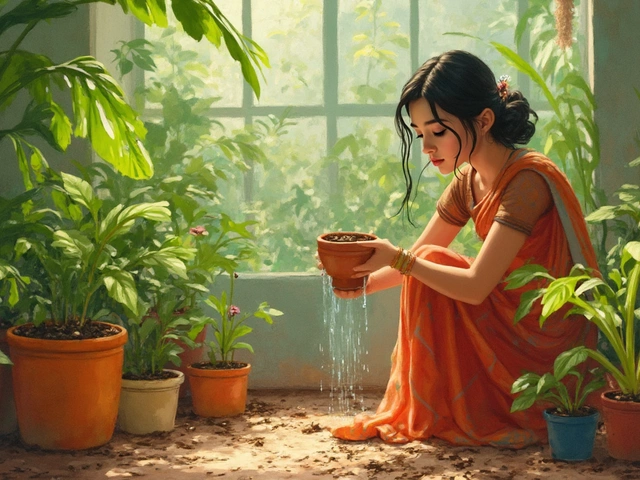Terracing opens a world of possibilities, transforming barren spaces into lush, thriving gardens. However, cultivating urban gardens high above ground level brings its unique set of hurdles. Protecting these delicate ecosystems requires a bit of know-how and a watchful eye.
Weather can be a formidable adversary on terraces, where exposure to harsh elements is intensified. Heavy rain, strong winds, and relentless sun can quickly do damage if proper safeguards aren't in place.
In addition, the challenge of maintaining optimal soil conditions cannot be overlooked. Ensuring good drainage and mitigating soil erosion are key to your plants' health.
Beyond environmental factors, terrace gardeners often grapple with a variety of pests seeking out a meal amidst their flourishing foliage. Keeping these unwelcome visitors at bay is another layer of protection.
Crafting an optimal environment for your terrace plants involves thoughtful design considerations, such as balancing sunlight with shade, and consistent, year-round care.
- Understanding Terrace Unique Challenges
- Weatherproofing Techniques
- Soil and Drainage Management
- Pest Control Strategies
- Designing for Shade and Sunlight Balance
- Year-Round Maintenance Tips
Understanding Terrace Unique Challenges
Creating a beautiful and productive terrace garden is akin to striking a balance between nature and nurture, sitting somewhere between the elements and the earth. The first step in overcoming obstacles is acknowledging the distinctive hurdles unique to these elevated gardens. Often, the most pronounced challenge is the relentless exposure to extreme weather conditions. Gusty winds, unyielding sunrays, and unexpected rain showers all conspire against your plants. Unlike garden beds huddled against the ground, terrace setups are perched in the whipping winds. This exposure can cause plants to become parched quicker than ground-bound counterparts, necessitating vigilant watering practices and the potential use of windbreakers or protective screens.
The structural implications for a terrace are substantial as well. Weight capacity concerns must be addressed from the outset. A thriving garden—rich with lush foliage or heavily weighted planters—can impose significant stress on the supporting structure of a terrace. It's vital to ensure that your outdoor space is not only capable of supporting this weight but also optimized for it to prevent long-term damage. This may involve seeking out lighter potting mixes or innovative lightweight container solutions to alleviate stress while still promoting plant health.
Another often overlooked aspect is the impact of urban pollution. Those lush garden plants are constantly being subjected to particulate matter from traffic and city environments which can settle on leaves, potentially inhibiting photosynthesis. Regular cleaning of leaves with water or gentle natural mixtures becomes imperative. This specific type of pollution may demand plants that are more tolerant of urban grime, such as hardy herbs or native plant species that have adapted to city living.
The varying microclimates within your terrace present a puzzle of sorts. Sunlit areas might favor one species of plant, while shaded sections suit another entirely. Getting to know these subtle climatic shifts can help you make more informed planting decisions. One method to manage sunlight exposure is through strategic use of shade cloths or trellises, which allow you to manipulate light and shadow to maintain a balanced environment for all plant varieties.
Timberley Johnson, an expert in urban horticulture, highlights the importance of understanding these challenges, saying,
"Successfully navigating the steep learning curve of terrace gardening means mastering the microcosm that exists high above city streets. It's not just about planting; it's about adapting to a world that merges human innovation with natural processes."With a keen understanding of these challenges, embracing terrace gardening becomes less daunting and more of an exhilarating adventure.
Weatherproofing Techniques
Creating a thriving terrace garden means battling the unpredictable elements that can wreak havoc on your carefully curated space. There are several strategies you can employ to shield your plants from weather woes. One crucial aspect is windproofing. Strong gusts can knock over pots, damage delicate plants, and strip away precious foliage. To combat this, consider erecting a windbreak. Depending on your style, this can range from simple bamboo screens to more elaborate trellises adorned with climbing plants. These barriers not only deflect wind but add a touch of personality to your garden.
Protection from heavy rain is another vital consideration. Excessive downpour can lead to soil erosion and root rot. To counteract this, ensure your pots and planter boxes are equipped with sufficient drainage. Placing a layer of gravel at the bottom of your pots can prevent water from stagnating. You might also explore installing a rainwater collection system, which allows you to harness rainfall for future use while preventing waterlogging.
Gardening expert Janet Wu once said, "A well-planned terrace garden doesn't just survive the elements—it thrives because of them."
Sun protection is equally essential in maintaining a balanced environment for your plants. While some species crave sunlight, intense exposure can scorch leaves and stunt growth. Retractable awnings or shade sails offer the flexibility to adjust based on the season and sun trajectory. Positioning potted plants strategically so some can provide shade to others is another clever tactic. This thoughtful design keeps fragile plants cool during sweltering afternoons.
The importance of temperature regulation cannot be overlooked either. In regions prone to extreme heat or sudden cold snaps, it's smart to opt for materials like terracotta or glazed ceramic for your pots. These materials excel at insulating soil, helping maintain a consistent temperature for roots. Protective wraps or insulating blankets can also be invaluable during unexpected frosts or cold winds.
Implementing these terrace protection techniques demands an observant eye. Watching how your terrace conditions shift throughout the day and seasons will guide your choices. Careful planning can turn your rooftop retreat into a resilient haven. And remember, every step taken in weatherproofing not only guards against destruction but also ensures your garden flourishes, no matter what Mother Nature throws at it.

Soil and Drainage Management
When it comes to terrace gardening, soil and drainage management are crucial components that can make or break the success of your garden. On a terrace, poor drainage can lead to waterlogged soil, which suffocates plant roots and invites diseases. Conversely, too much drainage can result in dry, parched conditions. Finding the right balance is essential to creating a flourishing garden. Using pots with adequate drainage holes is the first step. Ensure that these containers are raised slightly above the floor to prevent water from pooling. An effective technique is to layer the base of your planters with materials such as gravel or broken terracotta, which helps streamline excess water flow. This method not only improves drainage but also prevents root rot, a common ailment in compact terrace setups.
The type of soil used is equally important. Many terrace gardeners opt for a well-chosen blend of lightweight, well-aerated potting mix that holds moisture without becoming boggy. Avoid heavy garden soil as it tends to compact easily, restricting root growth. You might consider adding components like perlite or vermiculite to your potting mix, which can enhance air circulation and improve water retention capabilities. Amend organic material such as compost periodically to ensure nutrients are replenished. The correct soil composition forms the backbone of terrace gardening, encouraging strong root establishment and robust plant health.
Incorporating a terrace drainage system is another aspect worth exploring. This can be as straightforward as channeling rainwater through gutters and pipes, directing it away from the garden area. Not only does this help in preventing erosion of precious soil but it can also be harvested for later usage, bolstering the sustainability of your garden. Interestingly, a survey by the American Society for Horticultural Science revealed that properly managed drainage systems can improve plant vitality by up to 40%. Such benefits underscore the importance of integrating an efficient, organized approach to water management on terraces.
For those interested in implementing technology, smart irrigation systems that monitor moisture levels and automate watering during peak needs can be a game-changer. Available apps offer precision watering, ensuring each plant receives just the right amount of water, reducing both wastage and the risk of dehydration. Consider the insights from horticulturist Jane Moore who states, "The health of your garden is directly proportional to the health of your soil." These words remind us that attentive care to soil conditions yields sustainable growth and blooms that stand the test of time.
Pest Control Strategies
Combating pests on your terrace garden is an art form in itself, requiring patience, vigilance, and a bit of creativity. Elevation doesn’t always deter pests; in fact, it can sometimes invite an entirely new set of visitors. Understanding the ecosystem of your garden is the first step in determining which pests you might encounter and how best to address them without resorting to harmful chemicals. Many terrace gardeners swear by companion planting as a natural deterrent. For instance, incorporating marigolds into your garden can ward off nematodes and aphids due to their strong scent and natural pesticidal properties. Similarly, basil repels whiteflies and mosquitoes, making it ideal for planting with tomatoes and peppers.
Creating physical barriers is another effective method for protecting your plants. This can involve using nets or floating row covers that prevent pests from reaching your plants while still allowing light and water to penetrate. Birds, especially in urban environments, can also be problematic, pecking at young seedlings and ripening fruits. Simple strategies like hanging reflective CDs or using bird netting can be surprisingly effective. According to a study by the University of California, intentional planting of flowers like sunflowers and daisies can attract beneficial insects such as ladybugs, which naturally prey on damaging aphids and mites in your terrace gardening space.
Aside from these strategies, an organic approach to pest management involves the use of natural insecticides. One popular method is creating a homemade garlic spray, known for its strong scent that deters insects. To make this, blend garlic cloves with water and vegetable oil, and then strain into a spray bottle. Application should be frequent and ideally combined with other strategies for best effectiveness. For gardeners dealing with soil pests, introducing predatory nematodes can help control unwanted bug populations naturally. These microscopic organisms specifically target larval stages of many common pests, reducing the problem at its source without affecting your plants or beneficial insects.
Sometimes, battling pests is about encouraging a balanced ecosystem. Allowing certain insects into your garden can actually help maintain this balance. Spiders, for instance, are often undesired guests but their presence can greatly reduce other more harmful pest populations. Encouraging these natural predators by providing habitats and reducing pesticide use can protect your terrace garden in the long run. For a more comprehensive pest control strategy, consider adopting Integrated Pest Management (IPM) practices, which emphasize prevention and monitoring before resorting to intervention.
"Integrated Pest Management combines cultural practices and biological controls to minimize pest damage with the least disruption to the environment," notes Dr. Henry Ingram from the Institute of Urban Gardening Studies.
Pest control is not only about eradication but about maintaining harmony within your garden. Keeping detailed notes or a garden journal can assist in identifying patterns and recurring issues, facilitating proactive measures rather than reactive fixes. Taking photos and comparing seasonal changes can also help in understanding your terrace garden’s susceptibility to pests and adjusting your strategies accordingly.

Designing for Shade and Sunlight Balance
Creating the perfect blend of shade and sunlight on your terrace requires a mindful approach, where you consider not just the optimal growth conditions for your plants but also the visual harmony of your space. Many terrace gardeners may assume that more sunlight always equals better growth, yet this isn’t always the case. In the world of terrace gardening, too much sunlight can be just as detrimental as too little. Different plants call for varying light requirements, and the trick lies in positioning them thoughtfully to meet these needs. Consider architectural elements such as pergolas or lattices that can dapple the sunlight, providing relief during the blistering heat of noontime. You might also think about planting taller plants or climbers strategically to create natural shade for more delicate species.
The strategic planning does not stop at just architectural features or tall plant varieties though. It's also crucial to observe the sun’s path across your terrace throughout the day and over seasons. This can guide the placement of pots and containers, ensuring each plant gets its required dose of sunlight. A well-balanced environmental sense is key, as stated by horticultural expert Therese Holwick,
"In terrace gardens, achieving the right light balance often means success. Too much sun can stress plants, while too little can starve them."Her advice underscores the need to understand the specific lighting needs of each plant group, whether they're shade-loving ferns or sun-happy succulents. This human touch involves continuous observation, a bit of trial and error, and willingness to shift and rearrange as the seasons demand.
Practical Solutions and Adjustments
There are a myriad of ways to play with light on your terrace. Roll-up bamboo blinds can be rolled down during hotter parts of the day to protect plants from scorching. Alternatively, incorporate retractable awnings or umbrellas, which provide excellent shade flexibility. During the peak summer months, consider moving sensitive pots to shadier corners or next to reflective surfaces that can create an indirect lighting effect. For a more permanent touch, canvas sails make for a stylish addition that can span wider areas. These options allow you to manipulate exposure depending on seasonal changes or time of day. Remember, even synthetic solutions should be paired with natural adjustments, as these strategies together forge the path to a thriving, balanced terrace garden.
Experimenting with different arrangements brings another advantage: it maximizes the space you have. Creepers can scale walls, while cascading plants add volume and interest. Don't shy away from vertical gardening techniques, which not only maximize light exposure but also spotlight the majesty of multi-dimensional terrace gardens. Garden care involves some creativity, and through mindful design tweaks, a vibrant oasis can indeed be cultivated above the city's hustle and bustle.
Year-Round Maintenance Tips
Tending to a terrace garden is a constant journey, evolving with the seasons as much as the plants themselves. The key to thriving plants lies in meticulous yet flexible care routines that adapt to the shifting demands of weather, light, and growth cycles through the year. Each season ushers in its own set of tasks and potential hurdles, demanding a thoughtful approach to both planning and execution. In spring, for example, gardeners should focus on reviving their terraces from the relative dormancy of winter. This means inspecting the integrity of all containers, checking for cracks or other damage that winter may have inflicted. Replace any containers that could compromise the health of your soil or plants along the way.
As energetic summer days arrive, attention should turn to watering schedules, as terraces often expose gardens to unrelenting sunlight. Develop an irrigation plan that keeps soil consistently moist but never waterlogged, as excess water can be just as damaging as drought. Consider the popularity of drip irrigation systems; these deliver water directly to the plant base, reducing evaporation and ensuring efficiency. Shade structures might need to be adjusted or erected anew to protect certain plant species from the intense summer sun, offering crucial respite that can spell the difference between lush greenery and parched stalks.
Autumn, the season of transitions, calls for careful management of fallen leaves and debris, which, if left unattended, can contribute to disease and pest infestations. Regular cleanups help maintain aesthetic and horticultural health, turning what might otherwise become compost into a layer of insulation and nutrient-rich matter for the soil. By mulching the base of your plants, you fortify your garden against the creeping cold and optimize each plant's nutrient uptake.
Winter care involves strategic minimalism; while most garden activities slow, vigilance remains crucial, especially in periods of frost. Insulating plant bases, protecting outdoor plumbing fixtures, and periodically checking soil moisture prevent winter's harsh temperatures from wreaking havoc on your setup. As you turn the page with each seasonal transition, remember that gardening is as much an art as a science. "Gardening is the purest of human pleasures," remarked Francis Bacon long ago, and it's impossible to deny the joy that comes from applying mastery to this noble pursuit.
Cucumbers grown on rooftops can yield up to 10 kilograms per square meter. This statistic, provided by The Urban Agriculture Network, underscores the potential bounty tied to diligent care and considered strategy.
With the right approach, every season can bring abundant growth and fulfillment, making your terrace protection more than just a necessity—it's a life-affirming ritual.





